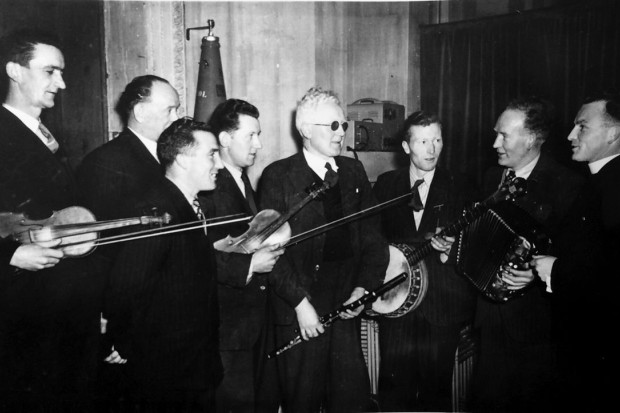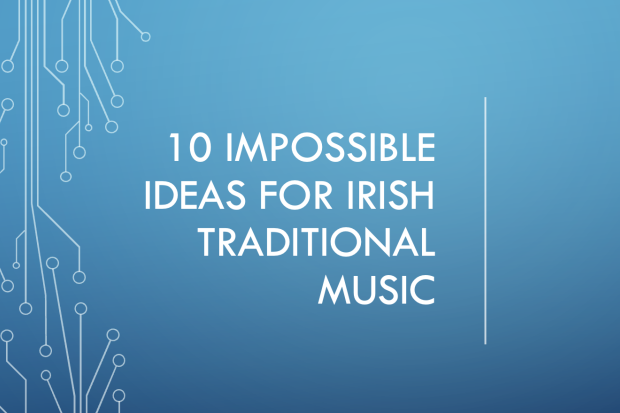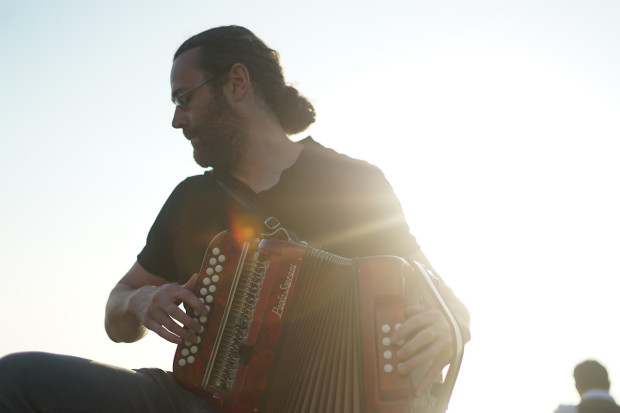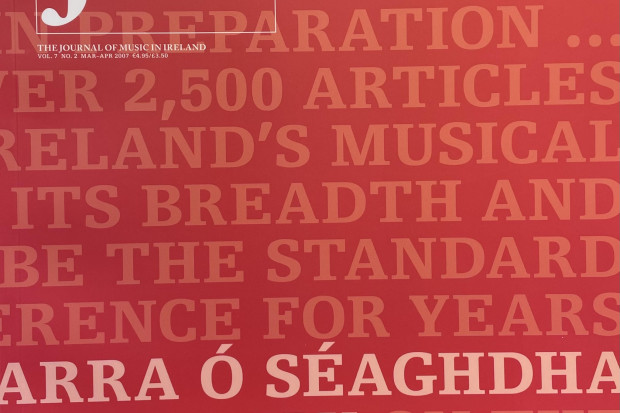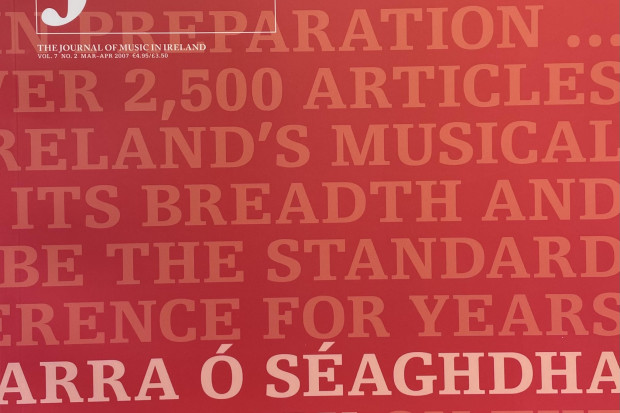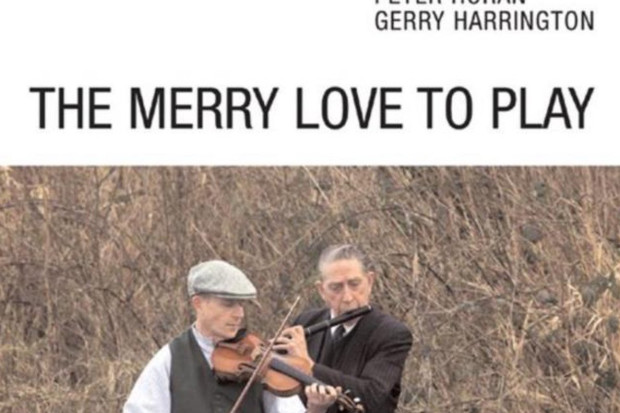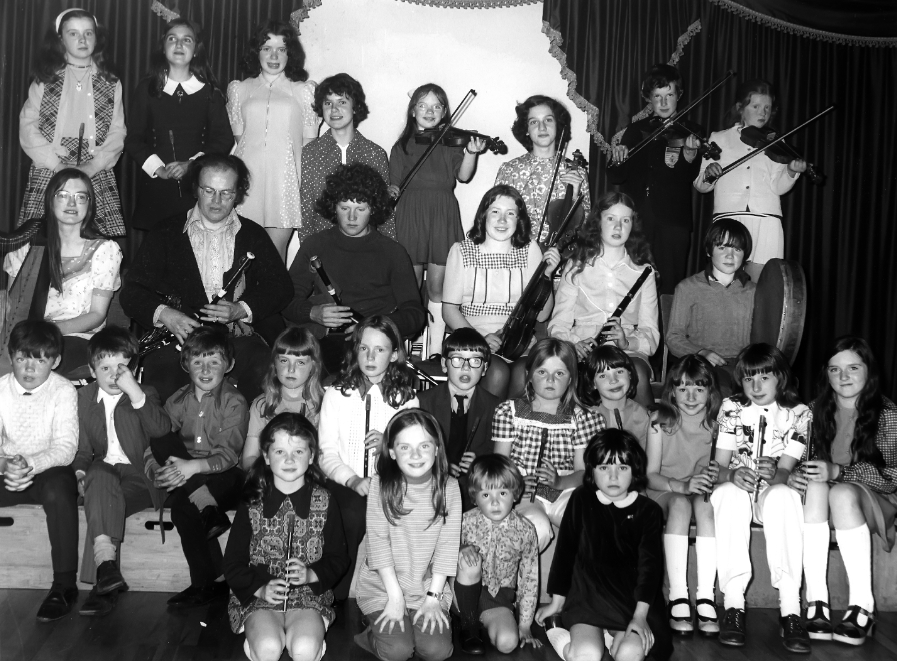
Class photo in the Old AOH Hall, Armagh in the early 1970s.
Forty-Five Years of the Armagh Pipers' Club
The Armagh Pipers’ Club was set up in 1966 by members of the local Comhaltas branch concerned about the future of uilleann pipe playing. They decided to form ‘a completely independent locally based organisation, which, while participating actively in, and supporting all Comhaltas Ceoltóirí Éireann events, did not seek membership of CCE’. Two of the key people in the Club, as it has gone from a special-interest group to a wide-ranging cultural force, have been Brian and Eithne Vallely, and to celebrate its first forty-five years they have produced a hard-back, large-format book containing a visual and written history of the Club as well as a collection of personal reflections and essays on its origins and impact. Among the contributors are Niall Vallely, Brian Finnegan, Jarlath Henderson, Roddy MacLeod, Brendan McGlinchey, Patrick Molard, Cillian Vallely, Rioghnach Connolly, Eamonn Curran and Mike Paterson, to name but a few. Here we publish an extract from Dr Fintan Vallely’s introduction to the book.
In the fashion of the middle years of the 20th century, just as all over the island, health-giving sport was the supreme, vital formula for social cohesion and community strength, music became but an adornment for character-improving or political occasions, a comfort – not considered of particular value in itself. Going further, far from today’s music associations (wherein, for instance, Guinness is the main sponsor of the All-Ireland Fleadh), drinking was perceived as the road to poverty and degradation, and ever present was the (political) adage ‘it was drink that brought us down’. I myself was born into a family where there was always song, but no music, although my mother’s father (in Co. Derry) had played fiddle and ran a céilí band. At the age of fourteen in 1963 I bought a tin whistle on impulse at Christmas, and taught myself to play it, picking up something from Cíarán MacMathúna’s broadcasts of Sligo and Clare music. Brian, my first cousin, from an equally non-music family, but similarly with a mother from a household in Mayo which was immersed in music, was smitten independently by piping four months later. Being older, and having disposable income though painting, his hungry energy sought out sources and occasions of music, and found in the Dublin Pipers’ Club a role model for the construction of a music movement in Armagh.
This embryo grouping he started with his brother Dara was greatly boosted after a couple of years by his new wife Eithne Ní Chiardha, she from an intense Donegal family hinterland of fiddling, and with time served transcribing the music of Ceol Rince na hÉireann with Sean Keane and Helena Rowsome for Breandán Breathnach. The Pipers’ Club attracted neighbouring musicians, crystallizing giddily and rapidly under Brian’s precise aesthetic instinct quite differently to the community orientation and local repertoire of the still-prevalent céilí bands. The Comac brothers Malachy (flute), John and James (fiddle), fiddler John Loughran, and banjo player John McCann from Tyrone, all of whom had already been in and resigned from CCÉ over aesthetics and politics issues, and who socialized with the great names of Tyrone, Antrim and Derry playing and singing, enthusiastically broadened the club’s repertoire, experience and scope in travel to sessions and fleadhanna ceoil. Visits to the Hayden home brought enervating and magical association with the radio-promoted ‘greats’ Peter Horan, Fred Finn and Peg McGrath. Overlapping with this was the power of Ó Riada’s model. His influence was astonishing for all musicians, for his radio programmes with Ceoltóirí Chualann were awaited impatiently and addictively by us all; it was logical that a Pipers’ Club performing ensemble based on his work came to be assembled and rehearsed.
The fact that all of this happened with no direct music background in the Vallely family by name is not to say that there was no foundation for it. On the contrary, our mutual grandmother had sung in collector Carl Hardebeck’s Gaelic Choir in Belfast, which had performed at the 1897 Dublin Feis Ceoil. Our fathers’ generation was immersed in the Irish language, Gaelic games and athletics, Radio Éireann was the broadcasting which was heard first thing each morning, last thing each night; our fathers travelled the island with sport, participating and then organising. Our childhoods were spent in transit to family and sport associations ‘over the border’; we were well familiar with the accents of other places from the earliest years, so perhaps it is small wonder that role models in music, when the awareness came, would be island based and aware of the significance of high standards.
I personally had no organisational role in forming the Pipers’ Club, though for my last four or five years in Armagh I was a regular performer, on flute and pipes, occasionally teaching the flute. Of ‘style’ I would hold that we simply learnt all that was available to be learnt in the pre-tutor-book era from wonderful players. Of ‘standards’, I can say that our mentors were, by dint of the island-wide ‘lost generation’ gap in traditional music transmission, pillars of music excellence and discernment in taste – among them Willie Clancy, Séamus Ennis, Paddy Bán Ó Broin, Johnny and Malachy Comac, John Loughran and John Hayden, Fred Finn, Peter Horan, Josie McDermott, Patsy Hanley, Peg McGrath, Seamus Tansey, Tom Mulligan and Felix Doran – all sought out by Brian’s instinct.
Style is not enough without standards, and while one must have a tremendous admiration for the precise well-attested idea of ‘style’ that is marked out by fiddling in Ireland, in honesty I could not say that I ‘do’ -–or feel I should or could do – any of them with the sophistication with which they are done on their home turfs. That consideration leads me to say that no, there is not an ‘Armagh’ style of performance that would mark the Pipers’ Club off in Ireland. Instead there is a pursuit there of as high quality, artistically driven playing as has always existed in traditional music in Ireland. Such is of course visible elsewhere too in the regionally-distinctive areas – in which the music did linger that longer. Yet it is gratifying to have been involved in my earliest years of playing with the Pipers’ Club structure, which had the luxury of not being burdened by either the guilt that one should be obliged to preserve a stylistic accent, or the necessity to give priority to such a legacy.
If it were to be the case that all players from non-regional regions were to be implicitly considered stylistically ‘wanting’, then, courtesy of touristic zealotry and football ethics, these would be consigned to a psychic limbo. But such a place, like hell, would then be the place to be. For it would contain the vast majority of players of traditional music, all of them better able to concentrate on, value and promote aesthetics and quality over locale, national awards and visibility. That bonus levels the pitch for regionally-specific and non-regionally-specific players. It would seem too, from my own years of experience of musicians in all styles, that anyway, away from the cameras, ‘style’ in fact is not divisive, but is most typically felt in exactly the same way as aesthetic discernment, and both, either alone or in unison, are the interchangeable pit props which support all standards.
The Armagh Pipers’ Club is a sizeable microcosm of this consideration. It has taught some 5,000 people by this day, and has produced, in healthy proportion, a sizeable number of virtuosic soloists who significantly are part of the traditional music avant-garde. But it is the other musicians and singers, those who are not particularly visible, who make up a sector of significance as fulfilling as a regional style – those for whom their lives have been enriched and educated with the ability to intelligently listen, perform, evaluate and appreciate, share and pass on a high calibre of traditional music. The jury should be out on whether or not there is a ‘Belfast style’ in flute playing, for it seems very likely that this nomenclature is a pragmatic, defensive reaction (by a region of high standards on flute) to fiddle-region supremacism.
But like it, the Pipers’ Club can only be appreciated for what it has created in four decades. For here is a mark on the map which is defined by more uilleann pipers per square mile than any other part of the island, and a catalogue of weekly music teaching, annual festival, public performance and names on headlines that sits comfortably with any regional tableau of Irish music performance.
Published on 3 September 2012
Fintan Vallely lectures in traditional music at Dundalk Institute of Technology. He is author of several biographical and ethnographic books on the music, and is editor of the A-Z reference work Companion to Irish Traditional Music.










